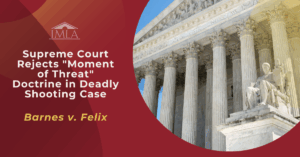16 May Supreme Court Rejects “Moment of Threat” Doctrine in Deadly Shooting Case
 Yesterday, the Supreme Court decided Barnes v. Felix, an important Fourth Amendment case for law enforcement involving the Fifth Circuit’s “moment of threat” doctrine, which only analyzes the reasonableness of the use of force at the moment the officer deploys deadly force. In a unanimous opinion, the Supreme Court rejected the Fifth Circuit’s narrow formulation, concluding the proper test is the “totality of circumstances” test and underscoring that a court “cannot review the totality of the circumstances if it has put on chronological blinders.”
Yesterday, the Supreme Court decided Barnes v. Felix, an important Fourth Amendment case for law enforcement involving the Fifth Circuit’s “moment of threat” doctrine, which only analyzes the reasonableness of the use of force at the moment the officer deploys deadly force. In a unanimous opinion, the Supreme Court rejected the Fifth Circuit’s narrow formulation, concluding the proper test is the “totality of circumstances” test and underscoring that a court “cannot review the totality of the circumstances if it has put on chronological blinders.”
This case involved a traffic stop that ended in the use of deadly force. Officer Felix was a traffic enforcement officer for Harris County, Texas. Another officer gave Felix information about a vehicle with outstanding toll violations and officer Felix located the vehicle and initiated a traffic stop. The driver, Barnes, pulled over and officer Felix parked behind him. The officer approached the driver’s side window and asked for license and proof of insurance. Barnes indicated that his girlfriend rented the car, and he did not have the documentation. Barnes indicated he “might” have the documentation in the trunk. The next several minutes were captured on video and ended tragically in Barnes’ death.
Felix ordered Barnes to open the trunk, and he did so. Felix then ordered Barnes to get out of the vehicle. Barnes opened the door but also turned the vehicle back on. Officer Felix then drew his weapon and shouted “don’t f’ing move” as Barnes’s vehicle began pulling away. The officer then stepped onto the moving car with his weapon drawn and while the car was moving, he shot Barnes. Two seconds elapsed from when Felix stepped onto the doorsill and when he shot Barnes.
Barnes’ estate sued the officer and County under Section 1983. The district court found there was no constitutional violation under the Fifth Circuit’s “moment of threat” rule because the officer did not draw his weapon until Barnes turned the car back on. The court further found that the officer’s actions prior to the moment the threat occurred justifying deadly force including that he “jumped onto the door sill” had “no bearing on the officer’s ultimate use of force.” And finally, the district court found that the “moment of threat occurred in the two seconds before Barnes was shot.” And at that moment, the district court found that the officer could reasonably believe he was “at risk of serious harm.” The Fifth Circuit affirmed on the basis of the moment of threat doctrine and concluded that any prior events “leading up to the shooting,” including actions the officer took were “not relevant.”
In a unanimous opinion authored by Justice Kagan, the Supreme Court reversed, holding that the moment of threat doctrine “improperly narrow[s] the requisite Fourth Amendment analysis” and that the proper inquiry “requires assessing the ‘totality of the circumstances.’” The Court emphasized its prior holdings including Graham v. Connor’s objective reasonableness standard, Tennessee v. Garner’s “totality of the circumstances” test, and Scott v. Harris’ reminder that the Fourth Amendment requires a court to “slosh [its] way through” a “factbound morass.”
The Court emphasized that the events leading up to the use of force are relevant to the totality of the circumstances and in some cases may help prove the officer’s actions were reasonable, such as the Plumhoff v. Rickard facts that involved a more than five minute “dangerous car chase” that preceded the deadly shooting. The Court noted that the shooting in Plumhoff “was justified ‘at the moment’ it occurred partly because of what had transpired in the preceding period.”
Factors courts should consider, which all derive from the Court’s prior case law, include the “severity of the crime,” “actions the officer took during the stop, such as giving warnings or otherwise trying to control the encounter,” as well as the “stopped person’s conduct” including the “nature and level of the threat he poses.” But, the Court cautioned, the totality of the circumstances test “has no time limit.” The Court did note that the “situation at the precise time of the shooting will often be what matters most.”
The Court rejected Officer Felix’s invitation to answer a separate question that, per the Supreme Court, the lower court had passed on: “whether or how an officer’s own ‘creation of a dangerous situation’ factors into the reasonableness analysis.” The Court similarly passed on answering this question several years ago in County of Los Angeles v. Mendez.
Justice Kavanaugh wrote a concurring opinion, which was joined by Justices Thomas, Alito, and Barrett to emphasize the dangerous nature of traffic stops for officers. As Justice Kavanaugh explained: “[i]n analyzing the reasonableness of an officer’s conduct at a traffic stop, particularly traffic stops where the driver has suddenly pulled away, courts must appreciate the extraordinary dangers and risks facing police officers and the community at large.”
To read the decision, click here.



